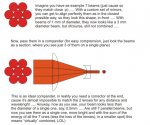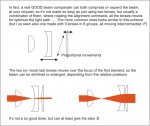If you get a custom made set of expander/corrector, you can also get as result a pseudo-beam that looks as a single one, where in fact it's made with all the beams paralleled and tightened as the more possible ..... but is for this reason, that i said theorically and high cost .....

Let me try to explain what i mean.
First of all, you need to align perfectly (and i mean
literally perfectly) all the incoming beams, parallele and with the less space between them (this can be made with a set of independent alignment mirrors, or a prismatic lens, but is not easy ..... enough to drive you so frustrated to bite the first one that say you "hello", and i talk for direct experience

)
Then the beam expander (that in reality is a compander) can left you enlarge the beam array or compress it, NOT combining together the beams, but reducing the size, so that the beams "look" so close that resemble a single one, but ofcourse, they are not combined ..... the only exception, as you said, is focusing them in a single point, where in this point (and only in this point), they become one (and before someone ask, no, is not so easy just reconvert this single point in a beam, LOL)
maybe the image is more clear than my bad english







